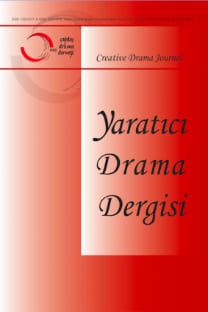Kadınların “Toplumsal Cinsiyet” Algılarının Renkler ve Objeler Üzerinden İncelenmesi
Türkiye’de “kadın olmak” oldukça karmaşık bir süreçtir. Kadın biriminin çalışmalarında tüm bu karmaşık yapının bütünü için söz söylemek yerine, yine bu karmaşık yapının parçası olan grubun kendi yaşantılarına dayalı çalışmalar yapılması uygun görülmüştür. Grubun yaşantılarını referans alan ve onu merkeze alan yaratıcı drama da birimin temel çıkış noktası olmuştur. Bu bildirinin temel sorusu, “Yaratıcı drama yöntemi ile uygulanan iki atölye sonucunda objelere yüklenen toplumsal cinsiyet algısında anlamlı bir değişim olmuş mudur?” dur. Bu çalışmada nitel araştırma yöntemlerinden durum çalışması kullanılmıştır. Grubun “kadın olmak” algısını araştırmak amacıyla gerçekleştirilen bu çalışmada kullanılan veriler görüşme ve gözlem aracılığıyla elde edilerek ulaşılan veriler tematik analiz yöntemi ile incelenmiştir. Çalışma kapsamında, kadın birimi katılımcılarıyla bir yıl süresince gerçekleştirilen yaratıcı drama atölyelerinin onların “kadın olmak” algıları üzerindeki etkisine dair sonuçlar karşılaştırılmıştır. Birinci ve son atölyede kullanılan objelerin canlandırılmalarda kullanım alanlarının değişiminden hareketle, objelere yüklenen “toplumsal cinsiyet” algısında bir fark olup olmadığına bakılmıştır. Yaratıcı drama yöntemiyle hazırlanan ve başlangıç ile süreç sonunda olmak üzere iki defa uygulanan atölye sonuçlarında ulaşılan veriler içerik analizi yöntemi ile değerlendirilmiştir. Süreç içerisinde toplumsal cinsiyet algısı kapsamında ele alınan temel çalışma konuları; kadın ve namus, kadınlaştırılma süreci, görünmeyen emek, medyada kadın, kutsallaştırılan annelik, kadınların nesneleştirilmesi, kadınlık rolleri, kadın ve din, kadının toplumda kapatılması, beden anatomisidir. Çalışmanın sonucunda, birim kapsamında yaratıcı drama yöntemi ile objeler üzerinden yürütülen çalışmaların katılımcıların toplumsal cinsiyet algısı üzerinde bir etkisi olduğu belirlenmiştir.
Investigation of “Social Gender” Perceptions of Women Through Colors and Objects
“Being a woman” in Turkey is quite a complicated process. It was deemed appropriate to conduct studies based on the experience of the group that is a part of this complicated structure rather than talking about the whole of this complicated unit. The main question of this unit is “Has there been a change in social gender perception attributed to the objects as a result of the two workshops practiced with creative drama method?” The case study among qualitative research methods was used in this study. The data obtained through interviews and observations so as to be used in this study that is conducted in order to examine the perception of “being a woman” were investigated with the thematic analysis method. The results of the effect of creative drama workshops carried out for a duration of one year with the participants of women unit on their perceptions of “being a woman” were compared within the scope of this study. Whether there is a difference in “social gender” perception attributed to objects was examined startingfrom the change in the areas of use in the animation of the objects used in the fi rst and last workshop. The main areas of working addressed within the scope of the social gender perception in the process are women and pudicity, the process of womanization, invisible labour, women in the media, sanctifi ed motherhood, objectivation of women, women roles, women and religion, confi nement of women in the society, and body anatomy. As a result of this study, it was determined that the studies conducted on objects using the creative drama method within the scope of the unit have an effect on the social gender perception. As a result of this study, it was observed that while the participants’ approach towards “being a woman” was based on problem, at fi rst, this approach turned into a solution-focused understanding as a result of a process of one year based on the examination of the subjects of women and pudicity, the process of womanization, invisible labour, women in the media, sanctifi ed motherhood, objectivation of women, women roles, women and religion, confi nement of women in the society, and body anatomy.
Keywords:
Social gender, Being a woman, Creative drama Women roles,
- ISSN: 1305-8177
- Başlangıç: 2006
- Yayıncı: Gençlik Kulübu ve Çağdaş Drama Derneği
Sayıdaki Diğer Makaleler
100 Temel Eser’de Kadın İmgesinin İncelenmesi
Kadınların “Toplumsal Cinsiyet” Algılarının Renkler ve Objeler Üzerinden İncelenmesi
Edebiyat Eğitiminde Unutulmuş Kadın Yazarlar
Kadınların “Toplumsal Cinsiyet” Algılarının Renkler ve Objeler Üzerinden İncelenmesi
Nami Eren Beştepe, Tuba Çay Sağlam
Kadın Müzesi “Kadın Eli Değen Müze”
Nami Eren Beştepe, Tuba Çay Sağlam
Masallar ve Toplumsal Cinsiyet Rolleri Oluşturma Sürecine Katkıları
Anadolu Kadınında Ezilmişliğin İtibarı
Çocuk Eğitimevindeki Kadın Görevlilerin Sanata Yönelik Görüşlerinin İncelenmesi
